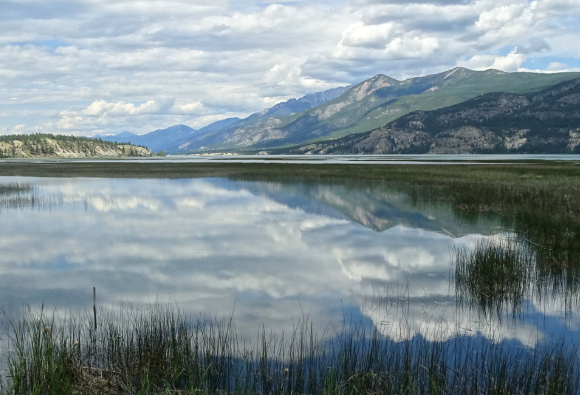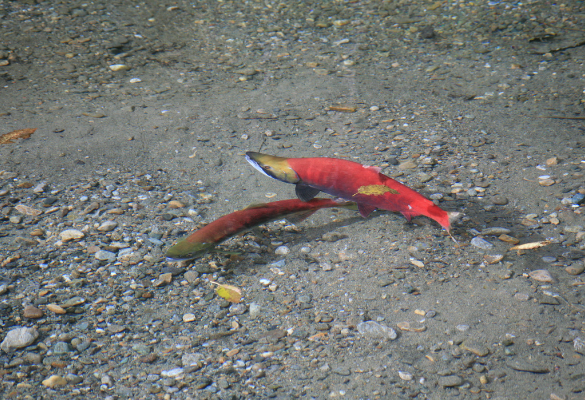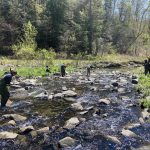The Youth Perspective: Setting Sockeye Salmon free in the Columbia River
Written by Trinda Cote, Indigenous Youth Ambassador with Living Lakes Canada. Artwork by Trinda Cote.
It was May 19, 2022 when I was given the opportunity to release Sockeye Salmon fry into the Columbia River. Sqlelten7úw̓i (Sockeye Salmon) (sq-loutn oo-ee) haven’t been seen in these waters for over 82 years and my Indigenous Band was going to finally reconnect with them. The salmon are a crucial part in my Indigenous history and the loss of these animals resulted in a great deprivation of culture, ceremony, and knowledge transfer, to name a few. This ceremony and experience was the moment I realized how important it is to protect our waters for the future generations.
It was finally the day. The salmon were coming home. Many members of Sécwepemc Bands (including my own), the Okanagan Nation Alliance, the Ktunaxa Nation, Shuswap Nation Tribal Council, Elders, Knowledge Keepers, and Youth all gathered to experience the reintroduction of Sockeye Salmon. As part of the Columbia River Salmon Reintroduction Initiative, this ceremony to call the salmon home was a grounding and inspiring experience. My people had lost a crucial part of our culture due to the Grand Coulee and Chief Joseph dams which obstructed the migratory routes for the salmon along the Columbia River. This ceremony was going to allow us to reconnect with our history and culture in more ways than one, and I was grateful I would be able to participate and witness the reintroduction. The kł cp̓əlk̓ stim̓ Hatchery in Penticton brought the fry in a large water truck. Before we released them, we sang songs and prayed for the salmon’s return. Each person who attended was able to release their own fry via a small paper cup.

The Sockeye Salmon were such a significant staple in my history. They were not just an essential food source for my ancestors to survive and sustain a healthy diet, they brought a communal factor too. The harvesting sites were widely used by the Secwépemc and the Ktunaxa people at a very specific time of the year when the salmon would return to spawn. We lost songs, ceremony, knowledge transfer, and much of the language used while fishing because there was no longer a use for it. As a result, future generations were not able to pass these words down. And we were not the only ones who relied on salmon. The ském̓cis (Grizzly Bear) (skmhees) and spel̓qwéqs (Bald Eagle) (spelkwalks) also heavily depended on the salmon to thrive.

Salmon specifically play an important role in freshwater ecosystems due to their migratory habits. As the salmon migrate from the ocean back to their spawning grounds, they transport nutrients from the ocean into these freshwater systems, which can benefit the ecosystem. Freshwater ecosystems are incredibly diverse and support a wide range of plant and animal species. These ecosystems provide very important habitats for a variety of species, including fish, amphibians, and insects.
The process of reintroducing salmon into an ecosystem is not a simple process. There are many needs that must be met in order for the salmon to survive and thrive. One of these includes the temperature of the water. In general, salmon need clean cold water throughout their life cycle. Another important factor is enabling up and downstream passage. An example of this would be a fish ladder and appropriate temperatures in their migration routes.
The salmon ceremony had a major influence on my decision to work for Living Lakes Canada. It helped me understand the importance of monitoring and protecting freshwater areas. My people have been able to reconnect with lost culture because individuals and organizations work tirelessly to keep these ecosystems conserved. I wanted to be part of this change while also bringing a youthful lens. As the Indigenous Youth Ambassador, I am able to be the bridge between Western science-based water stewardship and my Indigenous perspective. I hope my role at Living Lakes Canada can help provide impactful changes in our changing climate.
The salmon release was a massive step in the right direction in creating a system of continual positive changes that benefit people, ecosystems, and the environment. Future generations of Secwépemc youth deserve to see the salmon thrive, just like future generations around the world deserve to live in a healthy world.
Learn how to pronounce the species names in the traditional language of the Secwépemc People:
Sqlelten7úw̓i (Sockeye Salmon) (sq-loutn oo-ee)





